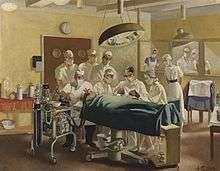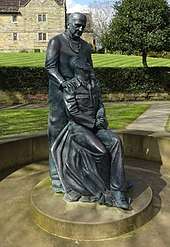Archibald McIndoe
Sir Archibald Hector McIndoe CBE FRCS (4 May 1900 – 11 April 1960) was a pioneering New Zealand plastic surgeon who worked for the Royal Air Force during the Second World War. He greatly improved the treatment and rehabilitation of badly burned aircrew.[1]
Early life
Archibald McIndoe was born 4 May 1900 in Dunedin, New Zealand, into a family of four.[2] His father was John McIndoe, a printer and his mother was the artist Mabel McIndoe née Hill. He had three brothers and one sister. McIndoe studied at Otago Boys' High School and later medicine at the University of Otago. After his graduation he became a house surgeon at Waikato Hospital.
In 1924 McIndoe was awarded the first New Zealand Fellowship at the Mayo Clinic in the United States to study pathological anatomy. The fellowship was for an unmarried doctor and as McIndoe had recently married Adonia Aitkin they had to keep their marriage secret and he sailed without her. When it was no longer possible to maintain the secret she joined him 12 months later. He worked in the clinic as First Assistant in Pathological Anatomy 1925–1927 and published several papers on chronic liver disease. Impressed with his skill, Lord Moynihan suggested a career in Britain, and in 1930 McIndoe moved to London.
When McIndoe could not find work, his cousin Sir Harold Gillies, an otolaryngologist specialising in plastic surgery (who now has an operation for reducing a broken cheekbone named after himself), invited him to join the private practice he ran with Rainsford Mowlem and offered him a job at St Bartholomew's Hospital, where he became a clinical assistant. In 1932 McIndoe received a permanent appointment as a General Surgeon and Lecturer at the Hospital for Tropical Diseases and the London School of Hygiene and Tropical Medicine.
In 1934, McIndoe received a Fellowship of the American College of Surgeons, where he worked until 1939. That year he became a consulting plastic surgeon to the Royal North Stafford Infirmary and to Croydon General Hospital. In 1938 he was appointed consultant in plastic surgery to the Royal Air Force.
Second World War

When the Second World War broke out plastic surgery was largely divided on service lines. Gillies went to Rooksdown House near Basingstoke, which became the principal army plastic surgery unit; Tommy Kilner (who had worked with Gillies during the First World War, and who now has a surgical instrument named after him, the kilner cheek retractor), went to Queen Mary's Hospital, Roehampton, and Mowlem to St Albans. McIndoe moved to the recently rebuilt Queen Victoria Hospital in East Grinstead, Sussex, and founded a Centre for Plastic and Jaw Surgery. There, he treated very deep burns and serious facial disfigurement like loss of eyelids. At McIndoe's instigation, patients at the hospital formed the Guinea Pig Club: members included Richard Hillary, Geoffrey Page, Bill Foxley and Jimmy Edwards.
McIndoe was a brilliant and quick surgeon. He not only developed new techniques for treating badly burned faces and hands but also recognised the importance of the rehabilitation of the casualties and particularly of social reintegration back into normal life. He disposed of the "convalescent uniforms" and let the patients use their service uniforms instead. With the help of two friends, Neville and Elaine Blond, he also encouraged the locals to support the patients and invite them to their homes. McIndoe kept referring to them as "his boys" and the staff called him "the Boss" or "the Maestro".
Important work included development of the walking-stalk skin graft, and the discovery that immersion in saline promoted healing as well as improving survival rates for victims with extensive burns – this was a serendipitous discovery drawn from observation of differential healing rates in pilots who had come down on land and in the sea.
Later years
After the end of the war McIndoe returned to private practice. His speciality was the "McIndoe nose".
McIndoe was created CBE in 1944 and after the war he received a number of British and foreign honours, including a Commandeur de la Légion d'honneur (Commander of the Legion of Honour)[3] and was knighted in 1947 for his remarkable work on restoring the minds and bodies of the burnt young pilots of the Second World War through his innovative reconstructive surgery techniques. That same year he visited East Africa for the first time, and took up farming on Kilimanjaro. It was here in 1956 with his two former pupils, Michael Wood and Tom Rees, that the dream of African Medical and Research Foundation (AMREF) was born.
He became a member of a council of the Royal College of Surgeons in 1946 and its vice-president in 1958. His marriage to Adonia ended in 1953, and he married Constance Belcham in 1954. In 1958 McIndoe was a Bradshaw lecturer about facial burns, a subject he knew well. He took part in the founding of the British Association of Plastic Surgeons (BAPS) and later served as its third President. The Guinea Pig Club continued to meet after the war, and McIndoe remained its President until his death.
Death
Archibald McIndoe died in his sleep of a heart attack on 11 April 1960, aged 59, in his house at 84 Albion Gate, London.[4] He was cremated, and his ashes were given the unique honour for a civilian of being buried at the Royal Air Force church of St Clement Danes.
Personal life
McIndoe married Adonia Aitkin of Dunedin on 31 July 1924. They had two daughters, Adonia and Vanora. They were divorced in 1953 and in 1954 McIndoe married Constantine Belcham, the former wife of Major-General R. F. K. Belcham.
Legacy

On 22 March 1961, the British Minister of Health opened the Blond McIndoe Centre named in his honour at the Queen Victoria Hospital, East Grinstead. The Blond McIndoe Centre, now named the Blond McIndoe Research Foundation, continues research into pioneering treatments to improve wound healing. The Blond McIndoe Research Foundation is a registered charity.
The McIndoe Burns Centre at Queen Victoria Hospital was dedicated in 1994, and there is a burns victim support group centred there which also bears his name.
Specialist science laboratories at Otago Boys' High School, built in 1967, are named in his honour.
The Gillies McIndoe Research Institute, a major medical research centre in Wellington, New Zealand, is named in honour of McIndoe and his cousin Sir Harold Gillies.[5]
In 2000 an English Heritage blue plaque was erected on McIndoe's former London home at Avenue Court, Draycott Avenue, Chelsea.
A bronze monument commemorating McIndoe by Martin Jennings, whose own father was one of his patients, was unveiled in East Grinstead High Street in 2014. It depicts a seated airman, his burned hands clawed together, his scarred face turned to one side. Standing behind him, resting a reassuring hand on each shoulder, is the figure of McIndoe. They are framed by a stone bench.[1]
Publications
- McIndoe, A. H.; Counsellor, V. S. (1926). "Primary carcinoma of the liver of possible multicentric origin occurring in a case of portal cirrhosis". American Journal of Pathology. 2: 557–66.
- McIndoe, A. H.; Counsellor, V. (1927). "A report on the bilaterality of the liver". Archives of Surgery. 15: 589.
- McIndoe, A. H. (1928). "[unknown]". Archives of Pathology. 5: 23.
- McIndoe, A. H. (1928). "[unknown]". Archives of Pathology and Laboratory Medicine. 6: 598.
- McIndoe, A. H. (1932). "Delayed haemorrhage following traumatic rupture of the spleen". British Journal of Surgery. 78: 249–68.
- McIndoe, A. H. (1937). "[unknown]". American Journal of Surgery. 38: 176.
- McIndoe, A. H. (1937). "Operation for the cure of adult hypospadias". British Medical Journal. 1: 385–404.
- McIndoe, A. H. (1937). "The application of cavity grafting". Surgery. 1: 535.
- McIndoe, A. H.; Banister, J. B. (1938). "An operation for the cure of congenital absence of the vagina". Journal of Obstetrics and Gynaecology of the British Commonwealth. 45: 490–494.
- McIndoe, A. H. (1938). "Correction of the alar deformity in cleft lip and palate". The Lancet. 1: 607.
- McIndoe, A. H. (1940). "[unknown]". Proceedings of the Royal Society of Medicine. 43: 43.
- McIndoe, A. H. (1941). "[unknown]". British Dental Journal. 71: 235.
- McIndoe, A. H. (1948). "Deformities of male urethra". British Journal of Plastic Surgery. 1: 29.
- McIndoe, A. H. (1948). "The treatment of hypospadias". British Journal of Plastic Surgery. 1: 29.
- McIndoe, A. H. (1949). "[unknown]". British Journal of Plastic Surgery. 2: 1.
- McIndoe, A. H. (1949). "[unknown]". Postgraduate Medicine. 6: 187.
- McIndoe, A. H. (1950). "Treatment of congenital absence and obliterative conditions of the vagina". British Journal of Plastic Surgery. 2: 254–67.
- McIndoe, A. H. (1950). "Discussion on the treatment of chronic oedema of the leg". Proceedings of the Royal Society of Medicine. 43: 1043.
- McIndoe, A. H. (1957). "[unknown]". The International Society of Plastic Surgery: 414.
- McIndoe, A. H. (1958). "[unknown]". American Journal of Surgery. 95: 197.
- McIndoe, A. H. (1958). "[unknown]". British Journal of Plastic Surgery. 10: 307.
- McIndoe, A. H. (1958). "[unknown]". British Journal of Plastic Surgery. 11: 62.
- McIndoe, A. H.; Rees, T. D. (1959). "Synchronous repair of secondary deformities in cleft lip and nose". Plastic and Reconstructive Surgery. 24: 150–61.
- McIndoe, A. H.; Simmons, C. A. (1959). "Discussion on the treatment of congenital absence of vagina with emphasis on long-term results". Proceedings of the Royal Society of Medicine. 52: 952–54.
- McIndoe, A. H. (1963). The McIndoe Memorial Research Unit: First Annual Report.
- McIndoe, A. H. (1971). "[unknown]". British Dental Journal. 71: 235.
- McIndoe, A. H. (1980). "[unknown]". British Journal of Plastic Surgery. 2: 254.
- McIndoe, A. H. (1983). "[unknown]". British Journal of Plastic Surgery. 41: 422.
- McIndoe, A. H. (1983). "Total reconstruction of the burned face: The Bradshaw Lecture 1958". British Journal of Plastic Surgery. 36: 410–20.
- McIndoe, A. H. (1987). "[unknown]". Surgery of Gynecology and Obstetrics. 164: 525.
- McIndoe, A. H. (1988). "[unknown]". British Journal of Obstetrics and Gynecology. 45: 490.
See also
- Mollie Lentaigne, a medical artist and nurse at East Grinstead who made drawings of McIndoe's procedures
References
- 1 2 de Quetteville, Harry (30 May 2014). "The pioneering surgeon who healed men scarred by war, a new monument created in his honour – and the remarkable twist of fate that links them". Daily Telegraph. Retrieved 31 May 2014.
- ↑ Meikle 2013, p. 109.
- ↑ M. Brewer, 'New Zealand and the Légion d'honneur: Officiers, Commandeurs and Dignites', The Volunteers: The Journal of the New Zealand Military Historical Society, 35(3), March 2010, pp.131–147.
- ↑ Meikle 2013, p. 195.
- ↑ Gillies McIndoe Research Institute website
Bibliography
- Bishop, Edward (2001). McIndoe's Army. London: Grub Street. ISBN 1-902304-93-4.
- Hodgkinson, Colin (1957). Best Foot Forward. London: Odhams. – autobiography of a double amputee (both legs) fighter pilot who was treated many times to repair facial damage
- McCleave, Hugh (1961). McIndoe: Plastic Surgeon. London: Frederick Muller.
- Mayhew, Emily (2006). The Reconstruction of Warriors: Archibald McIndoe, the Royal Air Force and the Guinea Pig Club. Greenhill Books. ISBN 1-85367-610-1.
- Meikle, Murray C. (2013). Reconstructing Faces: the art and wartime surgery of Gillies, Pickerill, McIndoe and Mowlem. Dunedin: Otago University Press. ISBN 978-1-877578-39-7.
- Mosley, Leonard (1962). Faces from the Fire: the biography of Sir Archibald McIndoe. London: Weidenfeld & Nicolson.